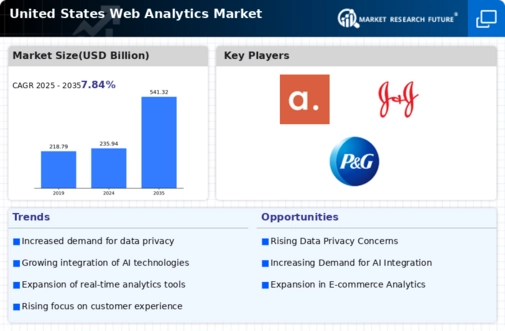Integration of Advanced Technologies
The integration of advanced technologies such as artificial intelligence and machine learning is transforming the web analytics market. These technologies enable businesses to analyze vast amounts of data more efficiently, uncovering patterns and trends that were previously difficult to identify. As organizations seek to enhance their analytical capabilities, the demand for sophisticated web analytics tools is expected to rise. The market is projected to reach a valuation of over $10 billion by 2026, driven by the increasing reliance on predictive analytics and automated reporting. This technological evolution not only improves the accuracy of insights but also allows for real-time data processing, which is becoming a critical requirement for businesses aiming to stay ahead in their respective industries. The web analytics market is thus positioned for substantial growth as these technologies become more prevalent.
Rising Importance of Customer Experience
In the current business environment, the focus on customer experience has become paramount, significantly impacting the web analytics market. Companies are increasingly utilizing analytics tools to understand customer journeys, preferences, and pain points. This shift is evident as organizations invest in technologies that provide deeper insights into user interactions across various digital platforms. Research indicates that businesses prioritizing customer experience are likely to achieve revenue growth of up to 5-10% higher than their competitors. As a result, the web analytics market is evolving to offer more comprehensive solutions that cater to this demand, including enhanced user segmentation and personalized marketing strategies. The emphasis on customer-centric approaches is driving innovation within the industry, making it a critical driver of growth.
Regulatory Compliance and Data Governance
The web analytics market is increasingly influenced by the need for regulatory compliance and robust data governance frameworks. As data privacy regulations become more stringent, organizations are compelled to adopt analytics solutions that ensure compliance with laws such as the CCPA and GDPR. This trend is prompting businesses to invest in web analytics tools that not only provide insights but also adhere to legal standards regarding data collection and usage. The market is expected to see a rise in demand for solutions that offer transparency and control over data practices. Companies that prioritize compliance are likely to gain a competitive edge, as consumers become more aware of their data rights. Consequently, the web analytics market is adapting to these challenges, fostering a landscape where compliance and analytics coexist harmoniously.
Expansion of E-Commerce and Digital Marketing
The rapid expansion of e-commerce and digital marketing is a significant driver of growth in the web analytics market. As more businesses transition to online platforms, the need for effective analytics tools to track performance and optimize marketing efforts becomes increasingly critical. The e-commerce sector alone is projected to surpass $1 trillion in sales by 2025, highlighting the importance of analytics in understanding consumer behavior and improving conversion rates. Companies are leveraging web analytics to refine their marketing strategies, enhance customer engagement, and ultimately drive sales. This trend is likely to continue, as businesses recognize the necessity of data-driven insights in navigating the complexities of the digital marketplace. The web analytics market is thus positioned to benefit from the ongoing digital transformation across various industries.
Growing Demand for Data-Driven Decision Making
The web analytics market is experiencing a surge in demand as organizations increasingly recognize the value of data-driven decision making. Businesses are leveraging analytics tools to gain insights into customer behavior, optimize marketing strategies, and enhance user experiences. According to recent estimates, the market is projected to grow at a CAGR of approximately 20% over the next five years. This growth is fueled by the need for companies to remain competitive in a rapidly evolving digital landscape. As more organizations adopt web analytics solutions, the industry is likely to witness innovations in data visualization and reporting capabilities, further driving adoption. The emphasis on actionable insights is reshaping the web analytics market, making it an essential component of modern business strategy.














Leave a Comment